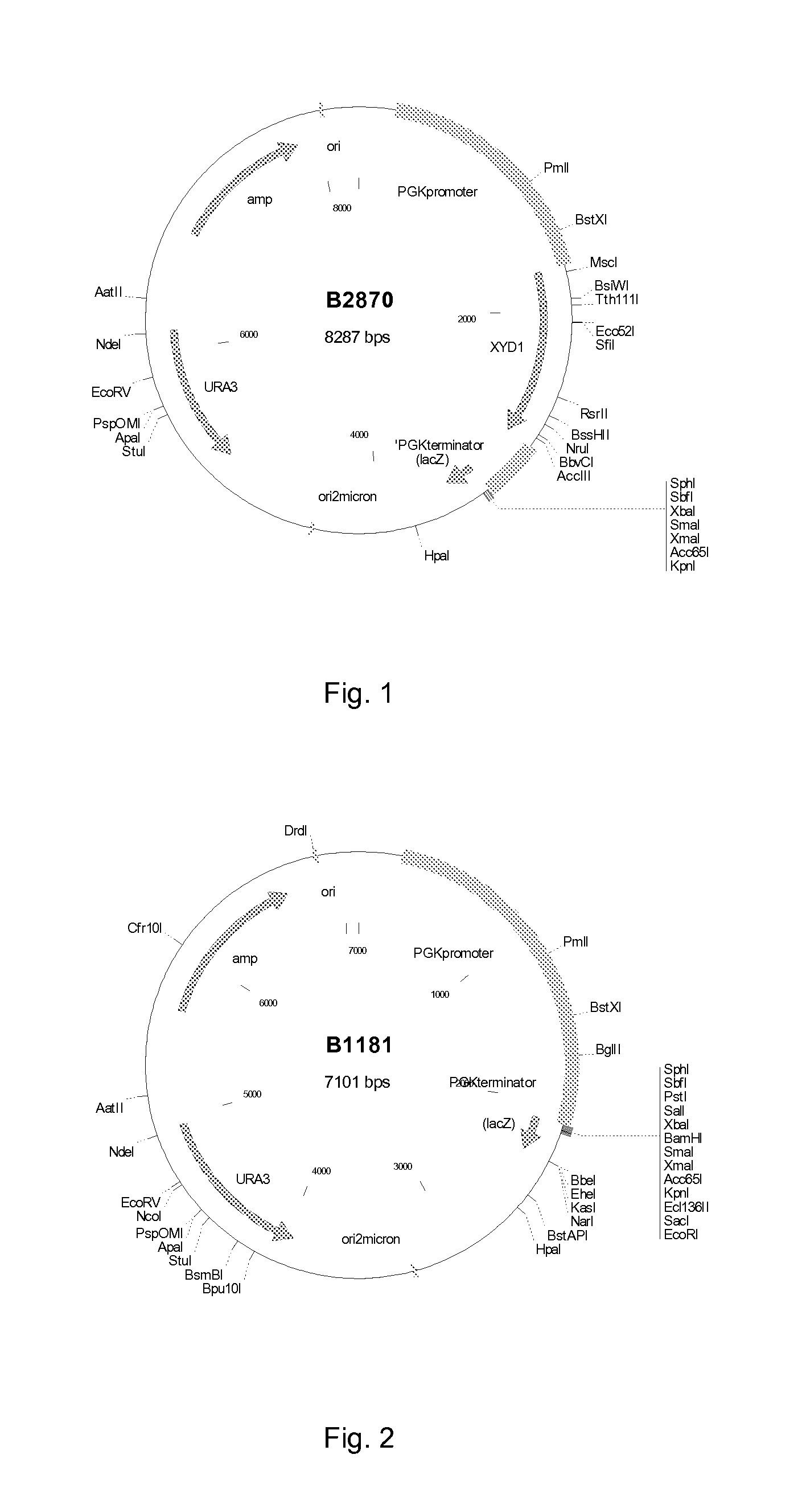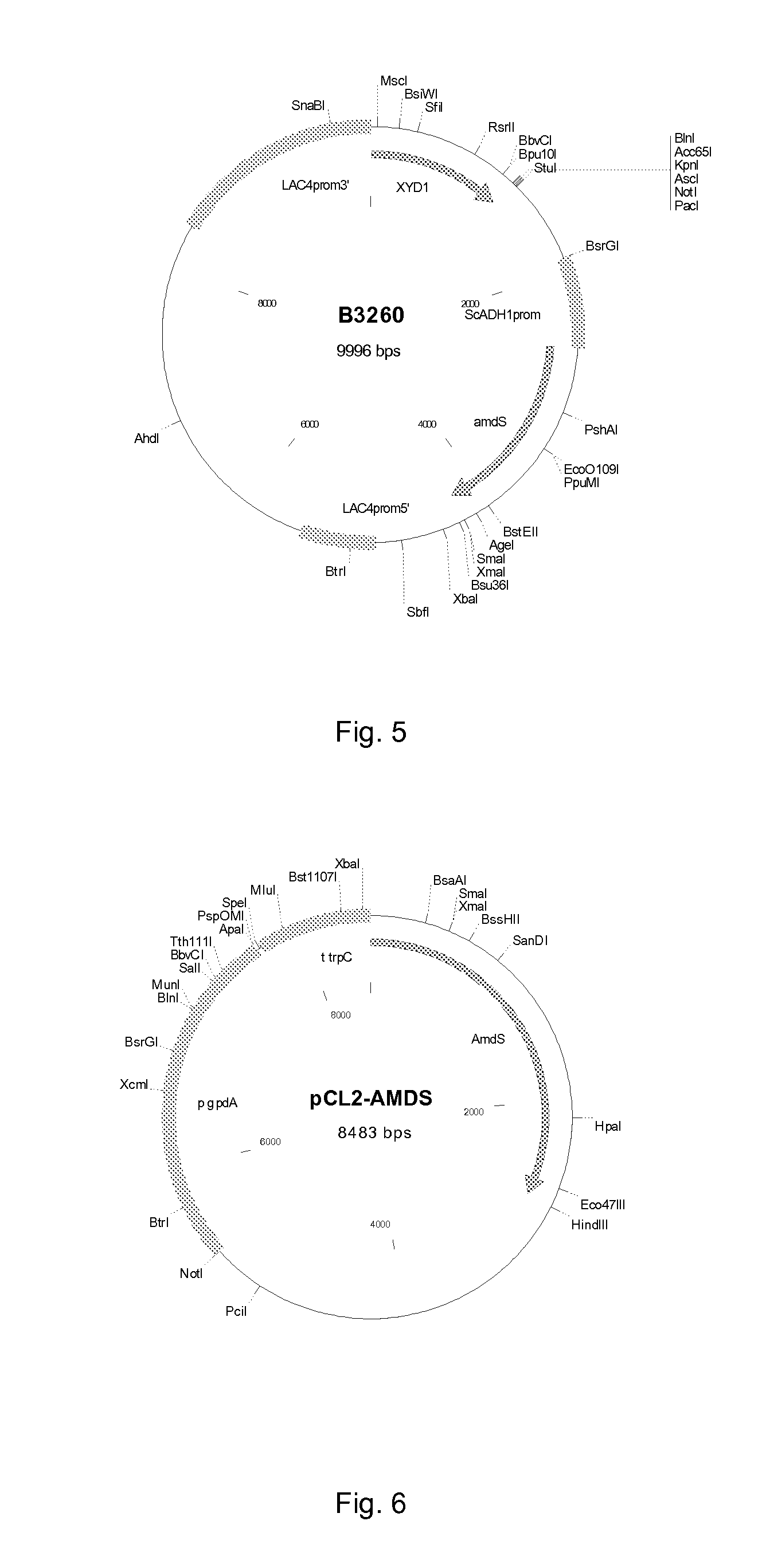Manufacture of xylonic acid
- Summary
- Abstract
- Description
- Claims
- Application Information
AI Technical Summary
Benefits of technology
Problems solved by technology
Method used
Image
Examples
example 1a
Construction of a S. Cerevisiae Strain Able to Produce Xylonic Acid (Self-Replicating Plasmids)
[0083]Plasmid B2870 (FIG. 1), containing the XYD1 gene encoding the Trichoderma reesei xylose dehydrogenase between the S. cerevisiae PGK1 promoter and terminator, was constructed using standard molecular biology methods. The XYD1 gene was amplified from a T. reesei cDNA library using PCR primer XYD1-a (SEQ ID NO: 13) and XYD1-b (SEQ ID NO: 14). The resulting fragment was ligated into the Bg / II site between the PGK1 promoter and terminator of YEplac195+PGK1PT (B1181, FIG. 2), generating plasmid B2870. Plasmid B2870 was introduced to Saccharomyces cerevisiae CEN.PK2-1D to generate strain H3494. Plasmid B2870 together with vector YEplac181+PGK1PT (B1184, FIG. 3), were introduced to S. cerevisiae CEN.PK2-1D by transformation to generate strain PR77. The PGK1 promoter and terminator (PGK1PT) of B1181 and B1184 was derived from vector pMA91 as HindIII fragment and cloned to HindIII site of vec...
example 1b
Construction of a S. Cerevisiae Strain Able to Produce Xylonic Acid (Integrated Cassettes)
[0085]Plasmids such as those described in Example 1A can be linearised using restriction digestion enzymes, in such a way that the 2 micron sequence (or autonomously replicating sequence, ARS, if appropriate) is deleted from the fragment containing the XYD1 expression cassette and selectable marker (e.g. LEU2 or URA3). These linearised fragments are then used to transform S. cerevisiae, with the result that the fragment is integrated into the genome. Integration may be random, or may also occur at a location for which there is homologous sequence present on both the fragment and in the genome (e.g. the PGK1 promoter or terminator or the URA3 gene in a fragment from B2870). The plasmids may also be modified to include specific sequences for targeted integration into the genome at the site of a specific gene, such as GRE3.
example 2
Construction of a Kluyveromyces Lactis Able to Produce Xylonic Acid
[0086]The XYD1 gene encoding the T. reesei xylose dehydrogenase was digested from vector B2870 with Bg / II, the fragment was made blunt ended and ligated into the pKLAC1 (Protein expression kit, New England Biolab, MA) vector digested with HindIII and Bg / Il and made blunt end, generating plasmid B3260 (FIG. 5). Plasmid B3260 was digested with SacII and transformed to Kluyveromyces lactis GG799 strain (renamed as H3632) as instructed by the kit manufacturer. Transformants were selected by growth on acetamide containing plates and integration of the XYD1 gene was verified by PCR. Transformants were named as H3677 and H3678.
PUM
| Property | Measurement | Unit |
|---|---|---|
| Acidity | aaaaa | aaaaa |
| Acidity | aaaaa | aaaaa |
| Acidity | aaaaa | aaaaa |
Abstract
Description
Claims
Application Information
 Login to View More
Login to View More - R&D
- Intellectual Property
- Life Sciences
- Materials
- Tech Scout
- Unparalleled Data Quality
- Higher Quality Content
- 60% Fewer Hallucinations
Browse by: Latest US Patents, China's latest patents, Technical Efficacy Thesaurus, Application Domain, Technology Topic, Popular Technical Reports.
© 2025 PatSnap. All rights reserved.Legal|Privacy policy|Modern Slavery Act Transparency Statement|Sitemap|About US| Contact US: help@patsnap.com



